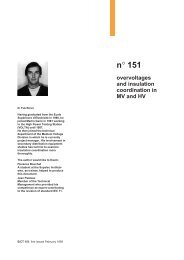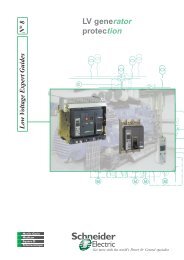sepam 20 user manual - Schneider Electric
sepam 20 user manual - Schneider Electric
sepam 20 user manual - Schneider Electric
You also want an ePaper? Increase the reach of your titles
YUMPU automatically turns print PDFs into web optimized ePapers that Google loves.
3<br />
Protection functions Earth fault<br />
ANSI code 50N/51N or 50G/51G<br />
Description<br />
The earth fault function comprises 4 independant<br />
elements divided into two groups of 2 settings called<br />
Group A and Group B respectively.<br />
The use of the two elements may be chosen by<br />
parameter setting:<br />
b operation with Group A or Group B exclusively, with<br />
switching from one group to the other dependent on the<br />
state of logic input I13 exclusively, or by remote control<br />
(TC3, TC4),<br />
I13 = 0 group A<br />
I13 = 1 group B<br />
b operation with Group A and Group B active for 4-set<br />
point operation<br />
b enabling/disabling of each group of 2 elements<br />
(A, B).<br />
DE50244<br />
DE50246<br />
Operation<br />
The earth fault protection function is single-pole.<br />
It picks up if the earth fault current reaches the<br />
operation set point.<br />
It is time-delayed. The time delay may be definite time<br />
(DT) or IDMT according to the curves opposite.<br />
The protection function includes harmonic 2 restraint<br />
which provides greater stability when transformers are<br />
energized (measurement of residual current by the sum<br />
of the 3 phase CTs).<br />
The restraint disables tripping, regardless of the<br />
fundamental current.<br />
The restraint can be selected by parameter setting.<br />
The protection function can be inhibited by input I23 for<br />
the S23 application only.<br />
Definite time protection<br />
Is0 is the operation set point expressed in Amps, and T<br />
is the protection operation time delay.<br />
Definite time protection principle.<br />
IDMT protection<br />
IDMT protection operates in accordance with the<br />
IEC (60255-3), BS 142 and IEEE (C-37112) standards.<br />
IDMT protection principle.<br />
3/26<br />
DE80109<br />
The Is0 setting is the vertical asymptote of the curve, and T is the operation time<br />
delay for 10 Is0.<br />
The tripping time for I0/Is0 values of less than 1.2 depends on the type of curve<br />
chosen.<br />
Name of curve Type<br />
Standard inverse time (SIT) 1.2<br />
Very inverse time (VIT or LTI) 1.2<br />
Extremely inverse time (EIT) 1.2<br />
Ultra inverse time (UIT) 1.2<br />
RI curve 1<br />
IEC standard inverse time SIT / A 1<br />
IEC very inverse time VIT or LTI / B 1<br />
IEC extremely inverse time EIT / C 1<br />
IEEE moderately inverse (IEC / D) 1<br />
IEEE very inverse (IEC / E) 1<br />
IEEE extremely inverse (IEC / F) 1<br />
IAC inverse 1<br />
IAC very inverse 1<br />
IAC extremely inverse 1<br />
The curve equations are given in the chapter entitled "IDMT protection functions".<br />
The function takes into account current variations during the time delay interval.<br />
For currents with a very large amplitude, the protection function has a definite time<br />
characteristic:<br />
b if I0 > <strong>20</strong> Is0, tripping time is the time that corresponds to <strong>20</strong> Is0<br />
b if I0 > 15 In0, tripping time is the time that corresponds to 15 In0.<br />
Block diagram<br />
Restraint<br />
I23 Input<br />
(for S23)<br />
&<br />
" "<br />
PCRED301005EN - 06/<strong>20</strong>08

















